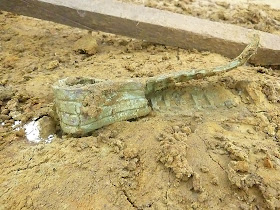(I should be "in the air" heading for digging in Belgium. Here's some background)
-----------------------------------------------------------------------------------------------------------
When I tell people here in the States that I am going over to do a bit of World War One archeology I don't get many detailed questions. Even with it being the one hundredth anniversary of The Great War it is not an era of history that is well known here. Mostly people assume it all started a short while before American involvement and that the American "dough boys" won it.
So a short discussion for those who will be following my time digging at Hill 80.
I'm going to be excavating a site on the edge of the Ypres Salient. It is the location of four continuous years of warfare in which perhaps 600,000 died. British, French, Belgian, German....very few Americans were anywhere near it.
Ypres was an old town, one of the centers of the medieval cloth trade. When the German army came sweeping into Belgium in 1914 they at first passed it by on their way to an attempted capture of Paris. When that failed the armies of both sides tried to grab onto whatever real estate they could before the campaigning season came to an end.
The front lines were just to the east of Ypres.
A series of battles were fought, either four or five depending on how you count them.
First Battle of Ypres 1914
Both sides stumble into each other. England had recalled her professional army from colonial duty while Germany had called up large numbers of young reservists, mostly University students. In confused fighting the British regular army was effectively destroyed, leaving the rest of the war to be fought by reservists, new volunteers and eventually draftees. On the German side the casualty rate was so appalling among the minimally trained student soldiers that it is remembered as the "Kindermort", the death of the children. (note, much of the legend of the passionate students singing as they went into battle is later, Nazi era propaganda. That these guys were poorly trained, poorly equipped and suffered horrendous casualties is quite true. When the initial lurch into France and Belgium stalled the German High Command basically put every guy they could find into short training programs and marched them off...)
Second Battle of Ypres 1915
Up on the northern edge of the Salient conditions were just right for the testing of a new form of devilry, poison gas. Clouds of chlorine gas were released and for a time the French troops broke and ran. Eventually the front stabilized and there it sat for two long years.
Third Battle of Ypres 1917
After long preparations a series of underground explosions were set off under the German lines on the southern edge of the Salient. This started a general offensive that ground forward until further advances were halted in the mud near a village called Passendaele.
Fourth (and Fifth?) Battles of Ypres 1918
When Russia left the war Germany was able to launch a series of last ditch attacks in the West. All the ground won by the Allies in the Ypres area was lost....but a few months later when the Germans ran out of energy (and yes, here the dough boys did play a late but important role) the British, French and Belgians were able to finally advance against minimal resistance. By this point everyone just wanted to survive to see the end of it all.
There is no compelling reason why Ypres was chosen as the location for the worst, longest battle of the worst and nearly longest war in modern times. Politically it was the last Belgian city that the Germans had not captured. And its loss could have led to logistic difficulties should it in turn lead to capture of the Channel ports such as Dunkirk.
But it was a stupid place to fight. The Germans were generally willing to give up real estate to occupy higher ground for more effective defense. The Allies on the other hand, spent four years sitting in a soggy, flat plain surrounded by defended hills. The city of Ypres was nearly leveled by artillery fire directed from, among other locations, Wytschaete where I will be excavating.
If you are interested in an extended discussion of the battles of Ypres I suggest A Storm in Flanders. It is written for an American audience and tends to avoid some of the extreme detail that would be important to the usual audience for such history, the British. The author is Winston Groom who oddly is most remembered for writing Forrest Gump!

















































